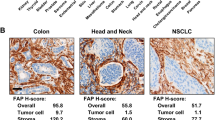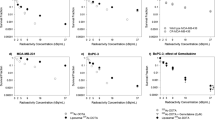Abstract
Purpose
The purpose of this study was to generate and evaluate a positron emission tomography (PET) radiotracer targeting activated leukocyte cell adhesion molecule (ALCAM).
Procedures
A human anti-ALCAM single chain variable fragment was reformatted to produce a covalent dimer, termed a cys-diabody (CysDb). Purified CysDb was characterized by gel electrophoresis and size exclusion chromatography, and immunoreactivity was assessed by flow cytometry and immunofluorescence. Targeting and imaging of ALCAM-positive tumors using 64Cu-DOTA-CysDb were evaluated in mice bearing human pancreatic adenocarcinoma xenografts (HPAF-II or BxPC-3).
Results
CysDb binds specifically to ALCAM-positive cells in vitro with an apparent affinity in the range of 1–3 nM. MicroPET images at 4 h showed specific targeting of positive tumors in vivo, a finding confirmed by biodistribution analysis, with positive/negative tumor ratios of 1.9 ± 0.6 and 2.4 ± 0.6, and positive tumor/blood ratios of 2.5 ± 0.9 and 2.9 ± 0.6 (HPAF-II and BxPC-3, respectively).
Conclusions
Successful imaging with 64Cu-DOTA-CysDb in animal models suggests further investigation of ALCAM as an imaging biomarker is warranted.




Similar content being viewed by others
References
Wu AM (2009) Antibodies and antimatter: the resurgence of immuno-PET. J Nucl Med 50:2–5
Wu AM, Olafsen T (2008) Antibodies for molecular imaging of cancer. Cancer J 14:191–197
Wu AM, Senter PD (2005) Arming antibodies: prospects and challenges for immunoconjugates. Nat Biotechnol 23:1137–1146
Cai W, Olafsen T, Zhang X et al (2007) PET imaging of colorectal cancer in xenograft-bearing mice by use of an 18F-labeled T84.66 anti-carcinoembryonic antigen diabody. J Nucl Med 48:304–310
Olafsen T, Cheung CW, Yazaki PJ et al (2004) Covalent disulfide-linked anti-CEA diabody allows site-specific conjugation and radiolabeling for tumor targeting applications. Protein Eng Des Sel 17:21–27
Sirk SJ, Olafsen T, Barat B, Bauer KB, Wu AM (2008) Site-specific, thiol-mediated conjugation of fluorescent probes to cysteine-modified diabodies targeting CD20 or HER2. Bioconjug Chem 19:2527–2534
King JA, Ofori-Acquah SF, Stevens T, Al-Mehdi AB, Fodstad O, Jiang WG (2004) Activated leukocyte cell adhesion molecule in breast cancer: prognostic indicator. Breast Cancer Res 6:R478–R487
Burkhardt M, Mayordomo E, Winzer KJ et al (2006) Cytoplasmic overexpression of ALCAM is prognostic of disease progression in breast cancer. J Clin Pathol 59:403–409
Kulasingam V, Zheng Y, Soosaipillai A, Leon AE, Gion M, Diamandis EP (2009) Activated leukocyte cell adhesion molecule: a novel biomarker for breast cancer. Int J Cancer 125:9–14
Weichert W, Knosel T, Bellach J, Dietel M, Kristiansen G (2004) ALCAM/CD166 is overexpressed in colorectal carcinoma and correlates with shortened patient survival. J Clin Pathol 57:1160–1164
Sawhney M, Matta A, Macha MA et al (2009) Cytoplasmic accumulation of activated leukocyte cell adhesion molecule is a predictor of disease progression and reduced survival in oral cancer patients. Int J Cancer 124:2098–2105
Mezzanzanica D, Fabbi M, Bagnoli M et al (2008) Subcellular localization of activated leukocyte cell adhesion molecule is a molecular predictor of survival in ovarian carcinoma patients. Clin Cancer Res 14:1726–1733
Chen R, Yi EC, Donohoe S et al (2005) Pancreatic cancer proteome: the proteins that underlie invasion, metastasis, and immunologic escape. Gastroenterology 129:1187–1197
Kristiansen G, Pilarsky C, Wissmann C et al (2003) ALCAM/CD166 is up-regulated in low-grade prostate cancer and progressively lost in high-grade lesions. Prostate 54:34–43
Kristiansen G, Pilarsky C, Wissmann C et al (2005) Expression profiling of microdissected matched prostate cancer samples reveals CD166/MEMD and CD24 as new prognostic markers for patient survival. J Pathol 205:359–376
Patel DD, Wee SF, Whichard LP et al (1995) Identification and characterization of a 100-kD ligand for CD6 on human thymic epithelial cells. J Exp Med 181:1563–1568
Bowen MA, Patel DD, Li X et al (1995) Cloning, mapping, and characterization of activated leukocyte-cell adhesion molecule (ALCAM), a CD6 ligand. J Exp Med 181:2213–2220
van Kempen LC, Meier F, Egeblad M et al (2004) Truncation of activated leukocyte cell adhesion molecule: a gateway to melanoma metastasis. J Invest Dermatol 122:1293–1301
van Kilsdonk JW, Wilting RH, Bergers M et al (2008) Attenuation of melanoma invasion by a secreted variant of activated leukocyte cell adhesion molecule. Cancer Res 68:3671–3679
Liu B, Conrad F, Cooperberg MR, Kirpotin DB, Marks JD (2004) Mapping tumor epitope space by direct selection of single-chain Fv antibody libraries on prostate cancer cells. Cancer Res 64:704–710
Liu B, Conrad F, Roth A, Drummond DC, Simko JP, Marks JD (2007) Recombinant full-length human IgG1s targeting hormone-refractory prostate cancer. J Mol Med 85:1113–1123
Roth A, Drummond DC, Conrad F et al (2007) Anti-CD166 single chain antibody-mediated intracellular delivery of liposomal drugs to prostate cancer cells. Mol Cancer Ther 6:2737–2746
Galfre G, Milstein C (1981) Preparation of monoclonal antibodies: strategies and procedures. Methods Enzymol 73:3–46
Olafsen T, Gu Z, Sherman MA et al (2007) Targeting, imaging, and therapy using a humanized antiprostate stem cell antigen (PSCA) antibody. J Immunother 30:396–405
Bebbington CR, Renner G, Thomson S, King D, Abrams D, Yarranton GT (1992) High-level expression of a recombinant antibody from myeloma cells using a glutamine synthetase gene as an amplifiable selectable marker. Biotechnology (NY) 10:169–175
Olafsen T, Kenanova VE, Sundaresan G et al (2005) Optimizing radiolabeled engineered anti-p185HER2 antibody fragments for in vivo imaging. Cancer Res 65:5907–5916
Loening AM, Gambhir SS (2003) AMIDE: a free software tool for multimodality medical image analysis. Mol Imaging 2:131–137
Nelson AL, Dhimolea E, Reichert JM (2010) Development trends for human monoclonal antibody therapeutics. Nat Rev Drug Discov 9:767–774
Leyton JV, Olafsen T, Sherman MA et al (2009) Engineered humanized diabodies for microPET imaging of prostate stem cell antigen-expressing tumors. Protein Eng Des Sel 22:209–216
Schmidt MM, Wittrup KD (2009) A modeling analysis of the effects of molecular size and binding affinity on tumor targeting. Mol Cancer Ther 8:2861–2871
Eder M, Knackmuss S, Le Gall F et al (2010) (68)Ga-labelled recombinant antibody variants for immuno-PET imaging of solid tumours. Eur J Nucl Med Mol Imaging 37:1397–1407
Schneider DW, Heitner T, Alicke B et al (2009) In vivo biodistribution, PET imaging, and tumor accumulation of 86Y- and 111In-antimindin/RG-1, engineered antibody fragments in LNCaP tumor-bearing nude mice. J Nucl Med 50:435–443
Anderson CJ, Ferdani R (2009) Copper-64 radiopharmaceuticals for PET imaging of cancer: advances in preclinical and clinical research. Cancer Biother Radiopharm 24:379–393
Shokeen M, Anderson CJ (2009) Molecular imaging of cancer with copper-64 radiopharmaceuticals and positron emission tomography (PET). Acc Chem Res 42:832–841
Yazaki PJ, Wu AM, Tsai SW et al (2001) Tumor targeting of radiometal labeled anti-CEA recombinant T84.66 diabody and t84.66 minibody: comparison to radioiodinated fragments. Bioconjug Chem 12:220–228
Ahlgren S, Wallberg H, Tran TA et al (2009) Targeting of HER2-expressing tumors with a site-specifically 99mTc-labeled recombinant affibody molecule, ZHER2:2395, with C-terminally engineered cysteine. J Nucl Med 50:781–789
Arano Y (1998) Strategies to reduce renal radioactivity levels of antibody fragments. Q J Nucl Med 42:262–270
Piazza T, Cha E, Bongarzone I et al (2005) Internalization and recycling of ALCAM/CD166 detected by a fully human single-chain recombinant antibody. J Cell Sci 118:1515–1525
Liu K, Lepin EJ, Wang M-W, Guo F, Lin W-Y, Chen Y-C, Sirk SJ, Olma S, Phelps ME, Zhao X-Z, Tseng H-R, van Dam RM, Wu AM, Shen CK-F (2011) Microfluidic-based 18F labeling of biomolecules for immuno-positron emission tomography. Molecular Imaging 10:168–176. doi:10.2310/7290.2010.00043
Horner MJ RL, Krapcho M, Neyman N, Aminou R, Howlader N, Altekruse SF, Feuer EJ, Huang L, Mariotto A, Miller BA, Lewis DR, Eisner MP, Stinchcomb DG, Edwards BK (eds) SEER Cancer Statistics Review, 1975–2006, National Cancer Institute. Bethesda, MD, based on November 2008 SEER data submission, posted to the SEER web site, 2009. Available at http://seer.cancer.gov/csr/1975_2006/
Parsons CM, Sutcliffe JL, Bold RJ (2008) Preoperative evaluation of pancreatic adenocarcinoma. J Hepatobiliary Pancreat Surg 15:429–435
Foss CA, Fox JJ, Feldmann G et al (2007) Radiolabeled anti-claudin 4 and anti-prostate stem cell antigen: initial imaging in experimental models of pancreatic cancer. Mol Imaging 6:131–139
Hausner SH, Abbey CK, Bold RJ et al (2009) Targeted in vivo imaging of integrin alphavbeta6 with an improved radiotracer and its relevance in a pancreatic tumor model. Cancer Res 69:5843–5850
Strickland LA, Ross J, Williams S et al (2009) Preclinical evaluation of carcinoembryonic cell adhesion molecule (CEACAM) 6 as potential therapy target for pancreatic adenocarcinoma. J Pathol 218:380–390
Vervoort L, Burvenich I, Staelens S et al (2010) Preclinical evaluation of monoclonal antibody 14C5 for targeting pancreatic cancer. Cancer Biother Radiopharm 25:193–205
Mariani G, Molea N, Bacciardi D et al (1995) Initial tumor targeting, biodistribution, and pharmacokinetic evaluation of the monoclonal antibody PAM4 in patients with pancreatic cancer. Cancer Res 55:5911s–5915s
Kahlert C, Weber H, Mogler C et al (2009) Increased expression of ALCAM/CD166 in pancreatic cancer is an independent prognostic marker for poor survival and early tumour relapse. Br J Cancer 101:457–464
Wiiger MT, Gehrken HB, Fodstad O, Maelandsmo GM, Andersson Y (2010) A novel human recombinant single-chain antibody targeting CD166/ALCAM inhibits cancer cell invasion in vitro and in vivo tumour growth. Cancer Immunol Immunother 59:1665–1674
Acknowledgements
Funding support was provided by the National Cancer Institute through the UCLA in vivo Cellular and Molecular Imaging Center (NIH CA 86306), the Stanford Center for Nanotechnology Excellence (NIH CA 119367), and the UCLA Small Animal Imaging Resource Program (NIH CA 92865), and a Dr. Ursula Mandel Scholarship. We thank Dr. Noah Federman for his help with the immunofluorescence experiments and Waldemar Ladno for his assistance with the animal studies. We would also like to acknowledge the UCLA Translational Pathology Core Laboratory for their antibody optimization and immunostaining services. Flow cytometry was performed in the UCLA Jonsson Comprehensive Cancer Center (JCCC) and Center for AIDS Research Flow Cytometry Core Facility, supported by NIH awards CA-16042 and AI-28697.
Conflict of Interest
Anna M. Wu owns stock and is a consultant to ImaginAb, Inc. James D. Marks own stock, is a member of the Scientific Advisory Board, and is a consultant to ImaginAb, Inc. The other authors declare they have no conflicts of interest.
Author information
Authors and Affiliations
Corresponding authors
Rights and permissions
About this article
Cite this article
McCabe, K.E., Liu, B., Marks, J.D. et al. An Engineered Cysteine-Modified Diabody for Imaging Activated Leukocyte Cell Adhesion Molecule (ALCAM)-Positive Tumors. Mol Imaging Biol 14, 336–347 (2012). https://doi.org/10.1007/s11307-011-0500-8
Published:
Issue Date:
DOI: https://doi.org/10.1007/s11307-011-0500-8




